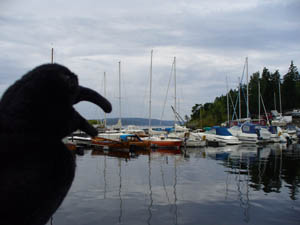 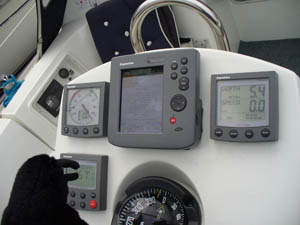 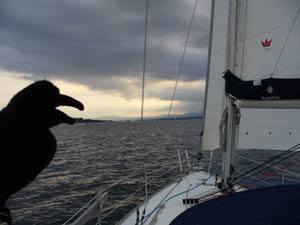 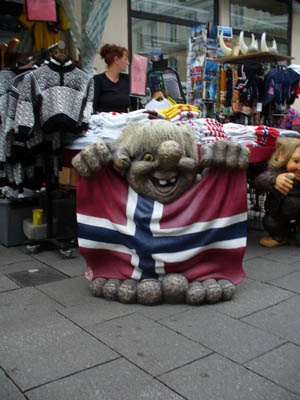 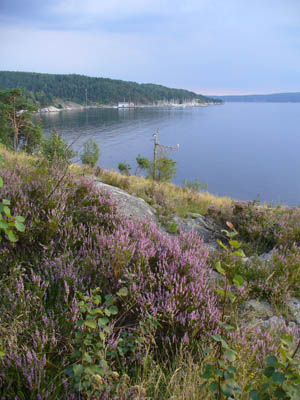 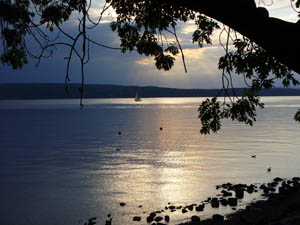 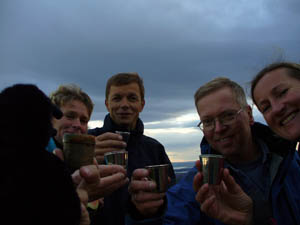 | WELCOME TO OSLO! Tuesday August 14 2007 So, what's the first thing you do when you arrive in Oslo, Norway? Go sailing, of course! After Kjersti and her husband Per Christian picked me up at the train station, we went straight to the marina where their 35' sailboat, Mar (means sea in Portuguese – they spent 2 years in Brazil), was moored. Kjersti made us dinner on the boat, then we unhitched the ropes (that is not nautical terms), motored out of the marina into the bay, raised the sails, and, the Raven II and I were sailing on Oslo Fjorden! We had wind for only 15 minutes, so we did more motoring than sailing today, but it was great to be out on the water (in Norway!) and not on a tour boat. And while out on the fjord we ran into (not literally) their friends Eli and Hans Jacob – the only ones they know in Oslo so far – just returning on their boat from their 6-week summer sailing holiday! Kjersti and Per Christian have had a sailboat for the last 10 years, and just the week before I arrived, they'd moved here to Oslo from Tromsø in the north of Norway – a 4-week sailing trip along the west coast. (They'd done the trip from Oslo to Tromsø a few years ago, also.) I later saw some pictures Hans Jacob took of their sailing trip down along the northwest coast of Norway, which were just stunning. Per Christian is maybe what you'd call obsessed with sailing – something I can relate to, since I'm a bit obsessed with endurance riding. Kjersti likes many outdoor sports – sailing, hiking, skiing, and you can do all of those in Norway, though your summer sports up north are a bit short-seasoned. The next day I hoofed it around Oslo. The city, and the area, reminds me much of Seattle, and Puget Sound: rain rain rain, green, wet, cloudy, gray, the green islands in the gray water, boats, hills and forests, more rain, fresh moist air, slugs, crows – it kind of made me homesick! Oslo, according to Norse legends, was established around 1049. The meaning of the name Oslo, from Old Norse, might be 'the meadow beneath the ridge' or 'the meadow of the gods'. Maritime history is an important part of Oslo and Norway. During the Viking age, from the 8th to 11th centuries, Norwegians founded settlements on Iceland, the Faroe Islands, Greenland, Britain and Ireland, and they reached Newfoundland, Canada. Today Oslo is home to some of the world's largest shipping companies and shipbrokers. Norway's produced some of the world's greatest explorers and adventurers, including Polar explorer Roald Amundsen, the first man to reach the South Pole. There's several museums dedicated to maritime history and treasures, including the Fram museum, where you can actually board the “world's strongest ship,” the Fram (means “Forward” in Norwegian), built in 1892 and used for 3 great polar expeditions. I mean, you can walk on and around the very ship that sailed the furthest North, and the furthest South of any ship, a ship that was icelocked for years at a time. The Fram was built with a special egg-shaped hull built to rise above the crushing pressure of the ice for when the ship would become icebound at the Poles. (If you've never read Alfred Lansing's “Endurance” for a vivid account of a Polar exploration, and ships caught in ice, you're missing out.) Outside is parked and preserved the ship Gjoa, which was the first ship to sail the Northwest Passage. You can also see, at another museum, the best preserved Viking Ships ever found, buried over 1100 years ago in 3 royal burial grounds by the Oslo fjord, to carry their royal owners “to the other side.” One evening we hiked up a nearby local hill with Hans Jacob and Eli. (The Raven came along). Hans carried up a watermelon and we sat up top overlooking Oslo and the Oslofjord under gray cloudy skies and a brisk (autumn already?!) wind. Currently on exhibition outdoors by the waterfront in Oslo is the wildlife photography of Steve Bloom: Spirit of the Wild. Large, stunning images of wildlife – makes you think you might as well pack away your camera, he's so good – that serve to remind man of “the fragility of the world, and our need to respet protect, and preserve it.” (I mean, really! How does he get some of these photographs!?) (see http://uk.co-life.net/ ) Some interesting thought-provoking facts presented by the exhibit: It now takes 6 weeks to consumer the same amount of oil that took one year to consume in 1950. Bottled water costs 1000 times the price of tap water. The average consumption of water per day by humans: a Madagascan farmer uses 10 liters a day, a European uses 250-350 liters a day, an American uses 600 liters a day. Public transport consumes 5 times less energy than a private car. The world population count: 1800 – 1 billion people. 1960 – 3 billion people. 2000 – 6 billion people. Since 1950, 30% of the planet's resources have been lost. 40% of sea life has been destroyed in the last 25 years by pollution Gas consumed per inhabitant per year: Sub-Saharan Africa – 31 liters per year. Asia – 50 liters per year. Western Europe – 427 liters per year. North America – 1637 liters per year. Other facts about Norway: it's the most peaceful country in the world, and Oslo is one of the most expensive cities in the world. And, Oslo has DR PEPPERS!! |
Tuesday, August 21, 2007
Oslo
Subscribe to:
Post Comments (Atom)
No comments:
Post a Comment